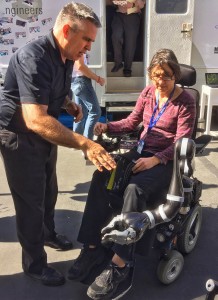Earlier this year, I met with multiple Occupational Therapists to learn about assistive technology to help people feed themselves. I assumed a task as common and necessary as feeding would have lots of AT options available. There have to be effective ways to lift food up and bring it to the mouth. The most common aides are adaptive utensils that are easier to hold. They have foam or a strap attached to the handle to require less hand dexterity and strength to use. They are marginally helpful for someone with reduced hand and arm function but for people who need more help, they are wholly insufficient.


The task of moving food from a plate to a mouth is complicated mainly because of the different textures and shapes of food. And besides that, I found no tools designed for helping people plate food to begin with.
I did find some feeding machines such as the Windsor which is decades old, weighs about 30 lbs, spins a plate and lifts a spoon. The design is so unwieldy and inconsistent; it was a tremendous hassle to set up and use. (apologies for the video quality!)
Also the modern version of it, called the Bestic, is smaller, faster, but still ineffective and dropped a lot of food. The only types of food it works reasonably for are stews. By the way, it costs $7000! There is also the brand new Jaba arm which could be used for feeding, unfortunately that costs over $50,000.
(video of Bestic machine. image of arm)
Overall, I came to the realization that AT manufacturers and designers have acknowledged the creating a feeding machine generalized enough for handling different types of food and environments and effective for use by people of varying abilities is not feasible or cost-effective. People with hand limitations are forced to migrate to full assistance in the form of caregivers and consuming liquid-only diets through feeding tubes and perhaps one of the most under-appreciated assistive technology devices, straws.

You are absolutely right- seems like this should be a problem that is solved…. but it’s really not. One of the early years of PPAT there was a team that produced a self-leveling spoon so that a client could eat soup. It was a nice design, but as you mentioned the wide variety of types and shaped of food make it very hard to scope the problem. The Jaba arm is super expensive now, but maybe as the price of robotics continues to fall a similar solution will eventually be affordable. With 3D printing technology and lower cost electronics, I’m hopeful it can happen.